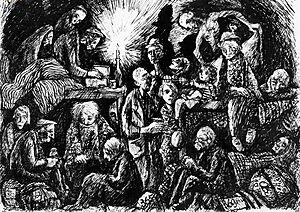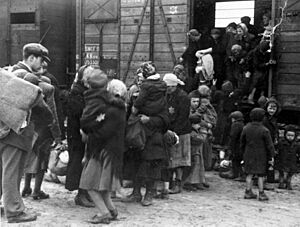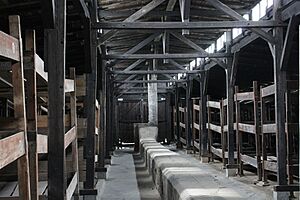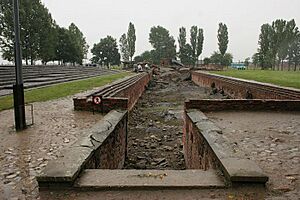Fredy Hirsch facts for kids
Quick facts for kids
Fredy Hirsch
|
|
|---|---|
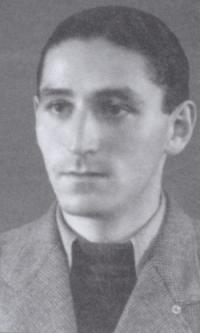
Alfred Hirsch
|
|
| Born |
Alfred Hirsch
11 February 1916 |
| Died | 8 March 1944 (aged 28) Auschwitz-Birkenau, German-occupied Poland
|
| Nationality | German Jew |
| Occupation | Athlete, sports teacher, Zionist youth movement activist |
| Organization | Jüdischer Pfadfinderbund Deutschland, Maccabi Hatzair |
| Known for | Helping Jewish children during the Holocaust |
| Partner(s) | Jan Mautner |
Alfred Hirsch (Hebrew: פרדי הירש; 11 February 1916 – 8 March 1944) was a German-Jewish athlete and sports teacher. He was also a leader in a Zionist youth movement. Fredy Hirsch is remembered for helping thousands of Jewish children during the Holocaust. He worked to protect them in Prague, Theresienstadt concentration camp, and Auschwitz.
Hirsch was a deputy leader for children in Theresienstadt. He later supervised the children's block at the Theresienstadt family camp in Auschwitz II-Birkenau. He was known for his strong personality and neat appearance. This helped him convince SS guards to give special treatment to children. These privileges included extra food and protection from being sent away, which saved their lives for a time. Fredy Hirsch and his helpers also secretly taught the children. Hirsch believed in exercise, discipline, and cleanliness. These rules helped keep the children healthier and reduced deaths among them.
The family camp was planned to be destroyed on March 8, 1944. Because Fredy Hirsch was so popular, he was seen as a natural leader for a possible uprising.
Contents
Fredy Hirsch's Early Life
Growing Up in Germany
Fredy Hirsch was born in Aachen, Germany, on February 11, 1916. His parents were Heinrich and Olga Hirsch. His father, who owned a butcher shop, died when Fredy was ten. Fredy and his brother, Paul, joined youth groups because they were not very close to their mother. Both brothers went to a school called Aachener Couven-Gymnasium, which was not a Jewish school. Fredy left in March 1931 when his mother moved.

In 1931, Fredy became a leader in the local Jewish youth association's scouting group. He also helped start the Aachen branch of the Jüdischer Pfadfinderbund Deutschland (JPD) in 1932. This was a German Jewish scouting group. Later that year, Hirsch moved to Düsseldorf to work for the JPD. The JPD was connected to Zionist ideas and worked closely with Maccabi Hatzair, a Zionist sports group. Fredy became a strong Zionist, supporting the idea of a Jewish state in what was then Mandatory Palestine (now Israel).
As antisemitism grew in Germany, the JPD training became more like military training. It focused on drills, marching with heavy loads, and first aid. In 1933, the JPD joined with Maccabi Hatzair. Hirsch then moved to Frankfurt, where he led a scouting group. He later moved to Dresden in 1934. There, he worked as a sports instructor for Maccabi Hatzair. He also likely took classes at the German College of Physical Education in Berlin.
Moving to Czechoslovakia
After the Nuremberg Laws were passed in 1935, Hirsch moved to Prague, Czechoslovakia. He continued his work for Maccabi Hatzair. The Czech branch of the organization was at first worried about his reputation. But Hirsch convinced Arthur Herzog, the chairman, that he was good at his job.
With money from the Zionist World Federation, Hirsch organized local Maccabiah Games. He also created youth and adult groups for physical education. In 1937, he organized the Maccabi Games for Czechoslovakia in Žilina, Slovakia. There were 1,600 people who took part. Until 1940, Hirsch ran a yearly youth camp at Bezpráví. Children and teenagers exercised and learned Hebrew there. Fredy's brother, Paul, moved to Bolivia with their mother in 1938. Fredy could have gone with them but chose not to. Paul later said Fredy's strong Zionist beliefs kept him in Europe.
After being told he could not live in Brno, Hirsch went back to Prague. He worked at the Zionist Youth Aliyah School. There, he set up training farms called hakhshara. These farms prepared young Jews to move to the Land of Israel and live on a kibbutz. They learned about gardening, farming, and basic military skills. In late 1938, Germany took over the Sudetenland region of Czechoslovakia. On March 15, 1939, Germany invaded Czechoslovakia. This created the Protectorate of Bohemia and Moravia. Many Czech Jewish children did not even know they were Jewish because their families had blended into the non-Jewish community. Eighteen boys trained by Hirsch escaped to Denmark in October 1939. They moved to Palestine the next year. Hirsch drew lots with another Zionist leader to see who would go to Palestine with the boys. Hirsch lost and stayed in Prague. In 1940, Jan Mautner joined him. Mautner could not continue his studies because Czech universities were closed. That same year, Hirsch wrote an article in a Prague Jewish Newspaper. He explained his ideas on Jewish youth education. He believed physical education was key to good health and Zionist awareness.
Over time, the Germans placed more and more rules on Czech Jews. They lost their jobs, were forced to move, and had their property taken. They were forbidden from certain shops and streets. Eventually, they had to wear the Star of David. After the Nazis banned Jews from public places, Hirsch created a playground at Hagibor in Prague. This was a place for Jewish children to exercise. Hirsch and Mautner held soccer games, sports events, study groups, and plays there. Hirsch was a natural leader because of his strong personality. He could not speak Czech well, so he gave instructions in Hebrew and taught the children that language. Survivors said that Czech songs were even written about him. In late 1941, the Nazis began sending Czech Jews away, first to the Łódź Ghetto. Hirsch helped prepare those being sent away with the 50 kilograms (110 lb) of luggage they were allowed to bring.
Fredy Hirsch During the Holocaust
Life in Theresienstadt
Fredy Hirsch was one of the first Jews sent to Theresienstadt concentration camp on December 4, 1941. He helped build the camp. His friendship with Jakob Edelstein led to him working in the housing department. Later, Hirsch became the assistant to Egon Redlich, the head of Youth Services. Redlich did not like Hirsch personally but respected his skills and leadership. Jan Mautner was also sent to Theresienstadt in early 1942. In Theresienstadt, children lived separately from adults. Hirsch believed in keeping self-respect, discipline, regular exercise, and strict cleanliness. He even held cleanliness contests. This was to give the children the best chance to survive. The youth leaders tried to keep teaching the children, even though it was forbidden. They taught many subjects like Hebrew, English, math, history, and geography. The Germans did not stop these activities because they thought it helped keep order. Children aged 14 and older had to work. Hirsch tried to get them jobs in the vegetable gardens. He believed this work would make them healthier and prepare them for life in Palestine.
Survivors often talked about Hirsch's confident attitude, good looks, and neat appearance. He always kept his hair combed and his boots polished. This had a good effect on other prisoners. He was able to build a good relationship with SS guards. According to Yehuda Bacon, "he spoke German as well as the Nazis, he had charm and a tip-top look. He knew how to talk to the SS. He was dressed like a soldier." Pavel Stránský, an educator at the children's block in Auschwitz, said that "The SS treated him almost like a human being."
Redlich and Hirsch used their influence to get separate barracks and slightly better conditions for the children. Sometimes they could remove children from transports going to extermination camps. However, they could not save them forever. More than 99% of the children in Theresienstadt were eventually sent away. Hirsch convinced the Germans to set aside space for a play area inside the camp. He often supervised sports activities there. In 1943, Maccabi Games were held, and thousands of people watched.
On August 24, 1943, a group of 1,200 children from the Białystok Ghetto arrived at Theresienstadt. These children were scared of the showers because they thought they were gas chambers. The Białystok children lived in the western barracks. They were separated from the rest of the camp by a barbed-wire fence. Czech police guarded the area and kept the children strictly apart from others. Hirsch wanted to find out if rumors about Jews being murdered in gas chambers were true. He managed to jump over the fence separating the Białystok children. But he was caught and arrested by a Czech guard. He was then taken to the commandant's office and beaten. Because of this, he was sent to Auschwitz on September 8.
Life in Auschwitz
When the Jews from Theresienstadt arrived at Auschwitz, they received special treatment. They were placed in a separate block (BIIb), known as the Theresienstadt family camp. They had numbers tattooed on them, but they were not immediately chosen for death. They could keep their own clothes and did not have to shave their heads. Families stayed together. They were also allowed to write to relatives in Theresienstadt, to those not yet sent away, and even to friends in neutral countries. This was to make it seem like being sent east did not mean death.
Hirsch was made the leader of the family camp. The SS respected his leadership. He refused to use violence against other prisoners, as the Germans wanted. Because of this, he was removed from his position a month later. He was replaced by Arno Böhm. However, Hirsch convinced Böhm to set aside a barracks, Block 31, for children younger than fourteen. Hirsch became the supervisor of this barracks. In this setup, children lived with their parents at night and spent the day at the special barracks. Hirsch found adult prisoners who had been teachers in Theresienstadt. He convinced the guards that it would be good for the children to learn German. But the teachers actually taught other subjects like history, music, and Judaism in Czech. They also taught a few German phrases for inspections. There were only twelve books and almost no supplies. So, the teachers had to remember lessons and teach them. The children had not been to school much, which made teaching harder. A choir practiced regularly, and a children's opera was performed. The walls of the barracks were painted with Disney characters by Dina Gottliebová. Because the block was so neat, it was shown to SS men from other parts of the camp. SS men involved in the killing process, especially Dr. Josef Mengele, visited often. They even helped arrange better food for the children.
Using his influence with the Germans, Hirsch got better food for the children. He also got food packages meant for prisoners who had died. The children's soup was thicker than for other prisoners. It was said to come from the Gypsy camp and had semolina. The children's barracks also received more coal and were a bit warmer. Hirsch also convinced the Germans to have roll call inside the barracks. This saved the children from standing outside for hours in bad weather. After another group arrived in December 1943, there were about 700 children in the family camp. Jan Mautner was also in this group.
Hirsch convinced Böhm to set aside a second barracks for children aged three to eight. This allowed the older children to prepare a performance of Snow White, which the SS had asked for. The play was performed on January 23, 1944, with many SS men watching. Hirsch made sure there was strict discipline among the children. This meant there was no violence or stealing, which was common in other parts of the camp. He was very strict about the children's cleanliness. He insisted they wash daily, even in the cold winter of 1943–44. He also did regular checks for lice. Because of Hirsch's efforts, almost no children died in his care. This was much lower than the 25% death rate for other family camp residents in the first six months. The children were thankful for Hirsch's help. They threw a surprise party for him on February 11, 1944, his 28th birthday. In February 1944, officials from the Reich Security Main Office and the German Red Cross visited the family camp. They were most interested in the children's barracks. This was the only place trying to organize education in Auschwitz. Adolf Eichmann, a very important visitor, spoke well of the children's activities at Birkenau.
Fredy Hirsch's Death
People arriving at the family camp were marked "SB6." This was a secret code that the resistance movement in Auschwitz later figured out. It meant Sonderbehandlung ("special treatment"), which was a code for murder. This meant that these prisoners would be killed six months after they arrived. For the group Hirsch was with, this date was March 8, 1944. Hirsch and other leaders from Theresienstadt were told about this plan by the resistance movement in Auschwitz. By this time, prisoners knew that the Germans were losing the war. Some hoped the Allies would win quickly before their six months were up. Even though success was unlikely, many Jews wanted to set the camp on fire as a symbol of resistance. Hirsch was the natural leader for an uprising. This was because different groups in the family camp respected him. On March 5, the prisoners who arrived in September were told they would soon be sent to a labor camp. They were told to write postcards dated March 25 to their relatives in Theresienstadt. On March 7, they were moved to the quarantine block (BIIa). Even though he knew the Nazis planned to kill all these Jews, Hirsch went with them.
What happened next is not fully clear. Rudolf Vrba, a clerk in BIIa, visited Hirsch on March 8. He told Hirsch about the plans to destroy the family camp. He urged Hirsch to lead an uprising. It seems Hirsch was unsure whether to believe the warnings about death. He also doubted if resistance would help. He thought it was strange that the Nazis would give them such good treatment only to kill them later. Hirsch asked for an hour to think. When Vrba returned, Hirsch was in a coma.
Fredy Hirsch's Legacy
After the war, people who knew Hirsch described him as "a man of extraordinary courage" and "for the children a God." Some adult colleagues, however, thought he was arrogant or too proud. In 2016, the cafeteria at the gymnasium in Aachen that he attended was renamed the "Fredy-Hirsch-AG." This was to celebrate his 100th birthday. At a ceremony in the Aachen synagogue, the Lord Mayor Marcel Philipp said Hirsch was "one of the most important sons of the city." Nina Weilová, who survived the Theresienstadt family camp as a teenager, said, "There was no one who was so self-sacrificing and devoted himself to the children as much as he did." Czech Jewish harpsichordist Zuzana Růžičková worked as a teacher's assistant in the children's barracks at Auschwitz. She said Hirsch saved her life. Many years later, she helped organize a monument for him. At the dedication, she said, "We Jews have no saints, but we have 'tzadikim'—the word could be translated as 'righteous' or 'decent'. Fredy Hirsch was a man, he had his faults, he was not a saint, but he was righteous—a tzadik—and so we hope that when the last of us who knew him have passed away, future generations will stand before this tablet and say: 'He must have been a good, brave and beautiful person'."

Hirsch was the subject of a 2016 documentary called Heaven in Auschwitz. This film shared the stories of thirteen survivors from Theresienstadt and Auschwitz. He was also featured in the 2017 Israeli documentary "Dear Fredy" by Rubi Gat.
According to historian Dirk Kämper, Hirsch's role was not fully recognized after the war. In communist Czechoslovakia, his German background and Zionist beliefs made him an unsuitable hero. Historian Anna Hájková notes that Hirsch's story is one of the few personal stories from the Nazi era that can still be told. Hirsch is a rare example of a Holocaust victim whose story is known. This is because he worked with children and teenagers, who lived long enough to share what they knew about him.
On February 11, 2021, Google celebrated his 105th birthday with a Google Doodle. The Doodle was shown in Germany, Czechia, Slovakia, and Israel.
See also
- Persecution of homosexuals in Nazi Germany




